Sony RX10 M3 - First Impressions
Some First Comments by Me | It's all there! | Some of My Settings | Weight and Size | The Lens | The Viewfinder | What Is Missing or Could Be Improved (in My Opinion)? | Conclusions
On this page, I would like to give away my first impressions of using the Sony RX10 M3 camera. At the end of March 2019, I replaced my RX10 M3 with its successor RX10 M4, but the comments on the RX10 M3 on this page also apply to the new camera, because both cameras are very similar. Therefore, this page covers both models.
Some First Comments by Me
So what can I say about the Sony RX10 M3 after a few months of use? First of all, I had to get used to it! Second, here are some first observations:
- The camera is indeed large and heavy. For details see below...
- It has quite a number of external buttons and controls that compact cameras do not offer. So, there is less need to dive into the menus than for compact cameras. On the other hand, I have to get used to this fact again, including using the display on the camera top for doing some settings...
- The viewfinder image is comparatively large, which I really appreciate. Although I can see the pixels, which I cannot see in viewfinders with lower magnifications (and the same resolution), it is really size that matters for me, not only for manual focusing, but also in general.
- The camera is easy to carry around despite its weight thanks to its grip. But for safety reasons, I always use a wrist or shoulder strap when doing so...
- My computer's hard disk is getting full now much earlier, because of the 20 MP sensor and JPEG images in "extra fine" compression - and thus, larger image files.
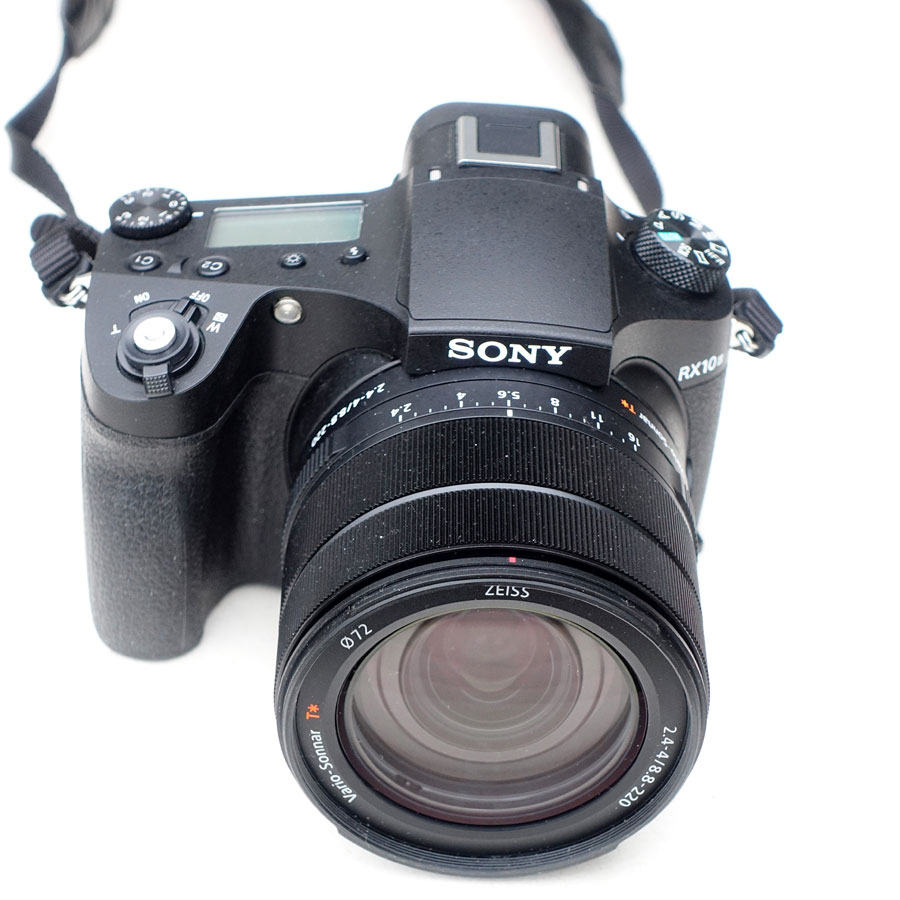 |
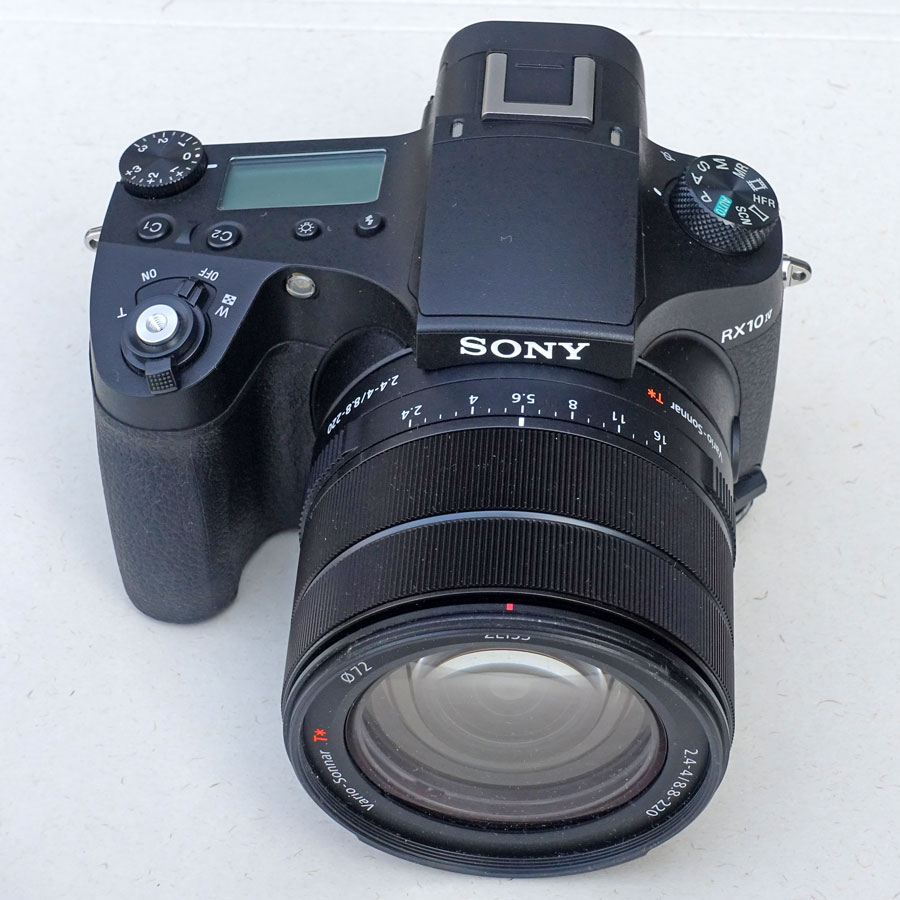 |
Photos: My Sony RX10 M3, about 1100 g heavy (left), and my Sony RX10 M4, which replaced it, about 1140 g heavy with lens cap that is not shown (right)
At the end of March 2019, I replaced my RX10 M3 with its successor RX10 M4, but the above comments also apply to the new camera, because both cameras are very similar.
It's all there!
When using the Sony RX10 M3 and M4, I have to say that "it's all there" what I need:
- Focusing (Focus Ring): Can be "manually" set at the lens by turning
the Focus
Ring - and needs some practice, because it it "by wire" and not mechanical.
But using Focus
Magnification and Focus
Peaking, I am successful most of the time. And since there are two lens
rings (Front and Rear Lens Ring), the camera allows me to decide,
which one I want to use for focusing (I chose the Front Lens Ring,
which is the default) - and I can even set the direction of rotation.
Cons: The manual focus has quite some hysteresis, and the correct focus point seems to move over time (not so on the Panasonic TZ202, thus, it can be done better...). - Zooming (Zoom Ring, Zoom Lever): Can be done using the Zoom Ring and/or the Zoom Lever. For the Zoom Ring you can also set step zoom (zooms in steps). The Zoom Ring has the same options as the Focus Ring and both rings can exchange their functions.
- Aperture (Aperture Ring): Is selected manually at the lens (Aperture Ring). Typically, you need this only in A or M mode.
- Shutter speed: Mostly, I use the camera in P mode, sometimes in A or M mode. In the first two cases, shutter speed is set automatically. Switching to A or M mode is easy thanks to the Mode Dial on the camera top.
- ISO: Can be easily accessed using a custom button on the top of the camera. But since this button is labelled C1, you have to remember which button sets ISO...
- Exposure compensation (Exposure Compensation Dial): There is a dedicated dial (Exposure Compensation Dial) on top of the camera for setting exposure compensation. The only issue that I have is that I have to look at this button to see in which state it is (it is also shown in the viewfinder)...
- Focus magnification: Is set to automatic by me and activated when I turn the lens's focus ring (Manual Focus Assist). Changing the magnification using the OK button is convenient. I also use Down button for activating focus magnification manually (Focus Magnifier).
- Level: Can be activated using the DISP button; I use it most of the time.
- Self-timer: Is rarely used by me... I can access it by presssing Left button of the camera, which I set to Drive Mode. I just have to remember this...
- Focus mode (Focus Switch): There is an explicit switch (Focus Switch) for setting the focus mode next to the lens.
- Lock focus (Focus Hold Button, AF/MF Toggle Function): I "reuse" the Focus Hold Button close to the lens for the AF/MF Toggle Function, which also provides me with kind of a focus hold function.
- Lock exposure (AEL Button): AEL is provided by the AEL Button, which I set to toggle mode so that I need not press the button all the time...
- Quick Menu (Fn Button): Provides access to many functions that I use more often so that I need not dive into the menu system for these functions.
Much more I (usually) do not need. My main issue is that I do not look at the camera when I start shooting... And I also do not care for the displays in the viewfinder...
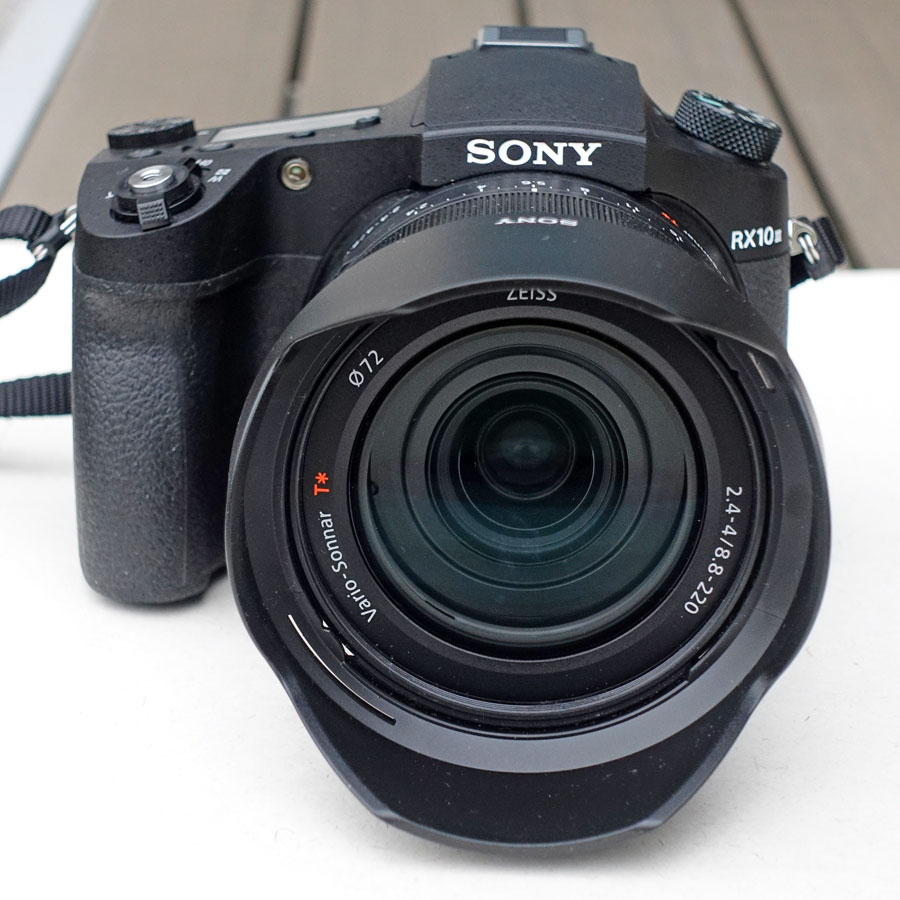 |
 |
|
Front view with lens hood RX10 M3 |
Rear view RX10 M3 |
|
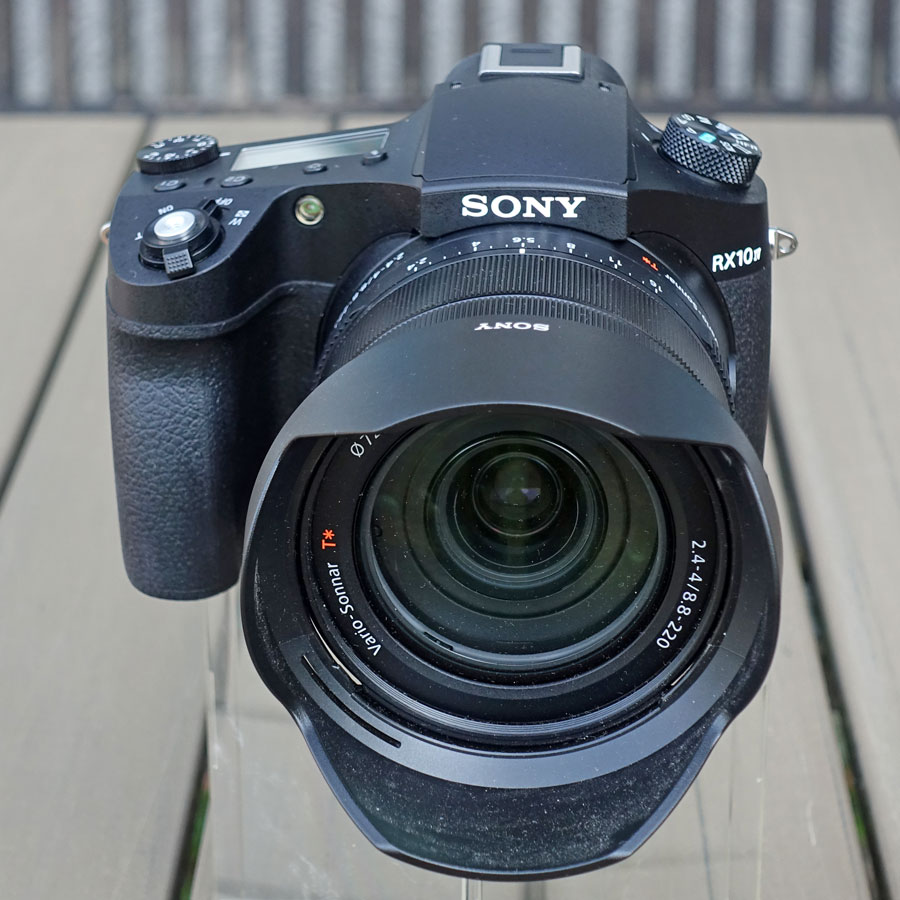 |
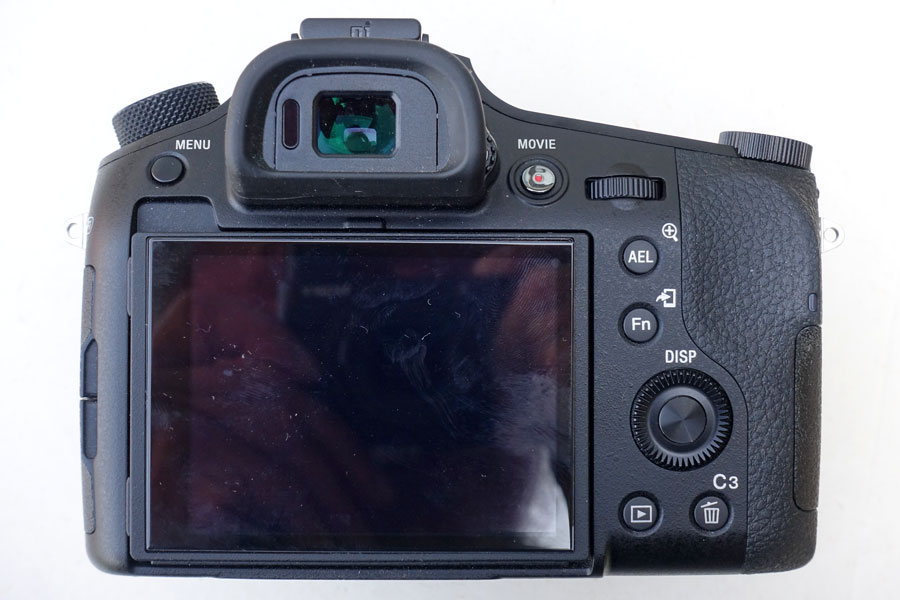 |
|
Front view with lens hood RX10 M4 |
Rear view RX10 M4 |
Photos: Views of the Sony RX10 M3 from the front and rear (top) and of the Sony RX10 M4 from the front and rear (bottom)
Some of My Settings
Favorite camera settings vary from photographer to photographer and also depend on the situation at hand. Therefore, it is difficult to recommend camera settings to other people. Nevertheless, I list some settings that I typically used on the RX10 M3 and now use on the RX10 M4 - maybe, they offer one or the other inspiration for others:
- Image Format: JPEG extra fine, 20 MP
- ISO: Between 100 and 1600 (often between 200 and 800), when it is dark ISO 1600, rarely ISO 3200
- Exposure Simulation: I set the function Live View Display to Settings Effects On - that is, yes!
- Exposure Compensation: Usually 0, sometimes -0.3 or even -0.7. Other values in special situations. I had set my previous cameras often on EV -0.3 to avoid blown-out highlights, but the sensor is "better behaved" in this respect...
- (Light) Metering Mode: Multi
- Focus Area: Flexible Spot or Center
- White Balance: Auto
- Acoustic Signal: Off
- Contrast, Sharpness, Saturation: Standard
- Focus Magnification: Automatic = As soon as you turn the Focus Ring on the lens, the enlarged detail appears (MF Assist). Moreover, I reserved a function key for activating this functionality manually (Focus Magnifier). In both cases, the enlargement factor can be changed by pressing the OK button.
- Focus Peaking: Red and Mid or High
- Level: On
For details see page Configuration.
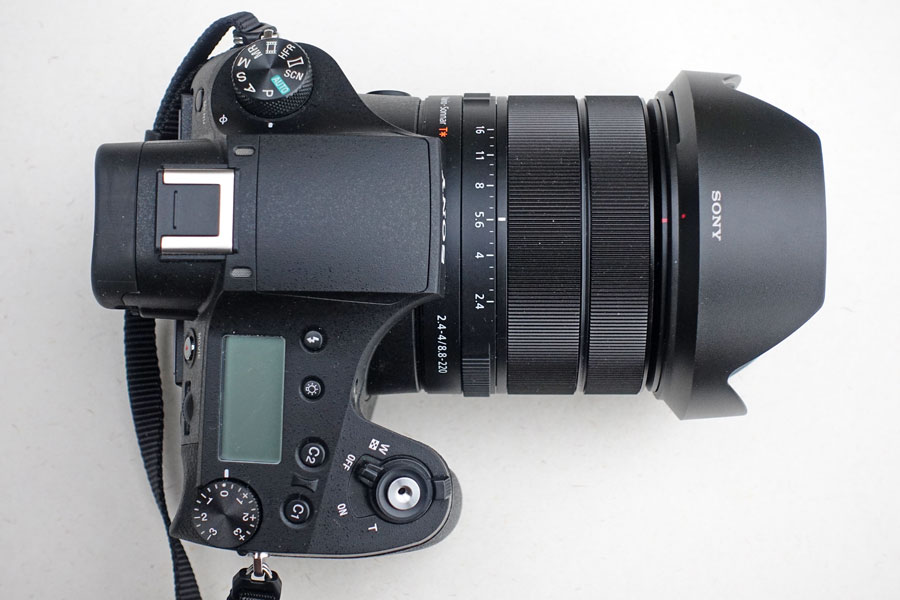 |
Photo: Top view of the Sony RX10 M3
Weight and Size
The Sony RX10 M3 is indeed heavy (about 1100 g). The camera hanging over my shoulder is too heavy for me after an hour or so. All in all, weight-wise, the Sony RX10 M3 is not my "ideal" camera... The Sony RX10 M4, which replaced my RX10 M3 after three months, has the same dimensions and weights on paper. In practice, however, I measured a weight of 1140g, that is, a little more...
The RX10 M3/4 is not at all a pocketable camera (and it is expensive, too). That is why I bought the Sony RX100 M4 and later the Panasonic TZ202 before I decided to buy this camera.
Size and weight comparisons can be found here.
The Lens
After all, the lens is definitely the most important ingredient of this camera, no matter whether RX10 M3 or M4 (it is identical in both models). With a focal length ranging from 24 mm to 600 mm (equiv.), it offers the largest range for a 1" sensor camera to date (April 2019). Given the issues with camera shake that I have at a focal length of 600 mm, I think that the zoom range suffices for me. If not, Clear Image Zoom might be a solution in some cases...
For me, the close-up behavior of the lens is also important. This mostly means that I want to achieve high magnifications from a distance (1 m and more). And that means using long focal lengths. So the closest focusing distance must be short enough to still achieve a sufficient magnification. This is unfortunately not the case with the Sony RX10 M3/4 in the focal length range between 100 mm and almost 400 mm. Above that (400 mm - 600 mm) it is good, and it is best at 600 mm, that is, at the long end of the focal length range!
Of course, high magnifications at the wide end are also welcome, if the objects are close enough and do not run away or fly away (shading can be a problem, though). Magnification is highest at 50 mm, where shading is less of a problem than with 24 mm or 28 mm.
Details can be found here.
The Viewfinder
Here are the technical data for the viewfinder of three of my cameras:
- Panasonic TZ202: Field-sequential display 2,330,000 dots / 0.53 x magnification
- Sony RX100 M4: 0.39-type electronic viewfinder (OLED) / 2,359,296 dots / 0.59 x magnification
- Sony RX10 M3/4: 0.39-type electronic viewfinder (XGA OLED) / 2,359,296 dots / 0.7 x magnification
So, the viewfinders all have the same resolution, but offer a different magnification.
I do not like the Panasonic TZ202's viewfinder very much. It has the lowest magnification, and often the view looks pale and blurred.
I like the viewfinder of the Sony RX100 M4 better. It has a slightly higher magnification, shows no pixels yet, has nice colors, but sometimes I have problems with the sharpness.
I like the Sony RX10 M3/4 viewfinder best. It has the highest magnification and the view almost looks like that from a DSLR camera. It has nice, but different colors than the RX100 M4, and because of the size of the viewfinder image I can recognize pixels. But that is not a problem for me. With this viewfinder, I like to photograph the most - it is amazing what this factor means to me!
What Is Missing or Could Be Improved (in My Opinion)?
- Manual focusing: Manual focusing with the focus ring at the lens
is a pain for me, because it is "by wire" and poorly implemented. So
my wishes for improvement are
- No hysteresis when turning the focus ring "by wire"
- Stable "in focus" position (no "wandering" of this position around the lens...)
- Autofocus: Autofocus is often hunting, particularly at long focal lengths and in low-light conditions. Sony's answer to this issue was the Sony RX10 M4, which has a phase detection autofocus system. So there is little hope that there will be any improvements for the RX10 M3, and so I replaced my RX10 M3 with a RX10 M4...
- Noise reduction: Less aggressive noise reduction with respect to fine details; dpreview.com recommends setting High ISO Noise Reduction to Low.
Conclusions
These are just a few preliminary ideas, comment, habits, opinions, and so on...
| 16.05.2023 |